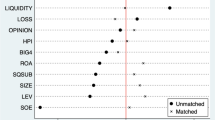Abstract
We study optimal government policy when firms' operations involve a risk of a large environmental accident, firms do not have sufficient assets to cover such costs, and the risk is affected by firms' efforts which are unobservable to outsiders. When firms' profits and government revenues have equal weights in the social welfare function, a first best can be implemented and requires that the firm be subsidized heavily when operating with no accident, and all its assets confiscated in the event of an accident. With a lower weight on firm profits the solution is always second best, with lower subsidies to the firm, and a firm effort lower than at the first-best solution. When firm investments affect both the required accident-preventing effort for given risk and the work effort required for a given output, the first best never involves specific investment subsidies, while a second-best solution generally always does.
Similar content being viewed by others
References
Amundsen, E. S. (1992), ‘Optimal Failure Rates and Penalty-Bonus Policies in the Offshore Petroleum Sector’,Environmental and Resource Economics 2, 469–489.
Baron, D. and R. Myerson (1983), ‘Regulating a Monopolist with Unknown Costs’,Econometrica 50, 911–930.
Baumol, W. J. and W. E. Oates (1988),The Theory of Environmental Policy, Cambridge University Press, Cambridge.
Beard, T. R. (1990), ‘Bankruptcy and Care Choice’,Rand Journal of Economics 21, 626–634.
Besanko, D. and D. E. M. Sappington (1987),Designing Regulatory Policy with Limited Information, Harwood Academic Publishers, London.
Brander, J. A. and T. R. Lewis (1986), ‘Oligopoly and Financial Structure: The Limited Liability Effect’,American Economic Review 76, 956–970.
Cropper, M. L. and W. E. Oates (1992), ‘Environmental Economics: A Survey’,Journal of Economic Literature 30, 675–740.
Gabel, H. L. and Sinclair-Desgagné (1993), ‘Managerial Incentives and Environmental Compliance’,Journal of Environmental Economics and Management 24, 229–240.
Glickman, T. S. and D. Golding (1992), ‘Recent Trends in Major Disasters and Industrial Accidents’,Resources 108, 9–13.
Grigalunas, T. A. and J. J. Opaluch (1988), ‘Assessing Liability for Damages under CERCLA: A New Approach for Providing Incentives for Pollution Avoidance?’,Natural Resource Journal 28, 509–533.
Hahn, R. W. (1990), ‘The Political Economy of Environmental Policy: Toward a Unifying Framework’,Public Choice 65, 21–47.
Holmstrøm, B. (1979), ‘Moral Hazard and Observability’,Bell Journal of Economics 10, 74–91.
Kohn, R. E. (1985), ‘A General Equilibrium Analysis of the Optimal Number of Firms in a Polluting Industry’,Canadian Journal of Economics 18, 347–354.
Laffont, J.-J. and J. Tirole (1986), ‘Using Cost Observations to Regulate Firms’,Journal of Political Economy 94, 614–641.
Laffont, J.-J. and J. Tirole (1990), ‘Adverse Selection and Renegotiation in Procurement’,Review of Economic Studies 57, 597–626.
Laffont, J.-J. and J. Tirole (1993),A Theory of Incentives in Procurement and Regulation, MIT Press, Cambridge, Ma.
Mayshar, J. (1977), ‘Should Government Subsidize Risky Private Projects?’,American Economic Review 67(2).
Myers, S. C. and N. S. Majluf (1984), ‘Corporate Financing and Investment Decisions When Firms have Information that Investors Do Not Have’,Journal of Financial Economics 13.
Nilsen, M. T. (1989),The Moral Hazard of Debt Finance: Theory of the Firm with Limited Liability, Mimeo, University of Copenhagen.
Opaluch, J. J. and T. A. Grigalunas (1984), ‘Controlling Stochastic Pollution Events Through Liability Rules: Some Evidence from OCS Leasing’,Rand Journal of Economics 15, 142–151.
Ringleb, A. H. and S. N. Wiggins (1990), ‘Liability and Large-scale, Long-term Hazards’,Journal of Political Economy 98, 574–595.
Schulze, W. D. and R. C. d'Arge (1974), ‘The Coase Proposition, Informational Constraints, and Long-run Equilibrium’,American Economic Review 64, 763–772.
Segerson, K. (1990),Institutional “Markets”: The Role of Liability in Allocating Environmental Resources. In Proceedings of AERE workshop on natural resource mechanisms.
Shavell, S. (1984), ‘A Model of the Optimal Use of Liability and Safety Regulations’,Rand Journal of Economics 15, 271–280.
Shavell, S. (1986), ‘The Judgment Proof Problem’,International Review of Law and Economics 6, 45–58.
Spulber, D. F. (1985), ‘Effluent Regulation and Long-run Optimality’,Journal of Environmental Economics and Management 12, 103–116.
Stiglitz, J. E. (1983),Risk, Incentives and Insurance: The Pure Theory of Moral Hazard, The Geneva Papers.
Stiglitz, J. E. and A. Weiss (1983), ‘Incentive Effects of Terminations: Applications to Credit and Labor Markets’,American Economic Review 73, 912–927.
Strand, J. (1993),Business Fluctuations, Worker Moral Hazard, and Optimal Environmental Policy, Mimeo, Department of Economics, University of Oslo.
Author information
Authors and Affiliations
Additional information
The paper is part of the research project “Environmental policy under asymmetric information', at the SNF Centre for research in economics and business administration, Department of Economics, University of Oslo. I thank, without implicating, Mikael Hoel, Jean-Charles Rochet, Jean Tirole, and two anonymous referees for helpful comments on a preliminary version.
Rights and permissions
About this article
Cite this article
Strand, J. Environmental accidents under moral hazard and limited firm liability. Environ Resource Econ 4, 495–509 (1994). https://doi.org/10.1007/BF00691925
Issue Date:
DOI: https://doi.org/10.1007/BF00691925




